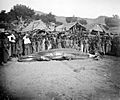Balaenoptera omurai facts for kids
Quick facts for kids Balaenoptera omurai |
|
|---|---|
 |
|
| Skull of Omura's whale | |
| Scientific classification | |
| Kingdom: | |
| Class: | |
| Subclass: | |
| Order: | |
| Suborder: | |
| Family: | |
| Genus: | |
| Binomial name | |
| Balaenoptera omurai Wada et al., 2003
|
|
The Omura's whale (scientific name: Balaenoptera omurai) is a fascinating type of whale. It's also known as the dwarf fin whale or little fin whale. For a long time, scientists didn't know much about this amazing creature. It was only officially recognized as its own species in 2003.
Omura's whales are a type of rorqual, which are the largest group of baleen whales. They can grow up to 11.5 meters (about 38 feet) long. These whales live in the warm waters of the Indo-Pacific region.
Contents
What is an Omura's Whale?
Omura's whales are a kind of baleen whale. This means they have special plates in their mouths called baleen instead of teeth. They use these plates to filter tiny krill and small fish from the water.
A Close Relative
For many years, scientists thought the Omura's whale was just a smaller version of the Bryde's whale. Bryde's whales are a group of very similar whales. However, after careful study, it was found that the Omura's whale is a unique species. This discovery was made by comparing their DNA and physical features.
Where Do Omura's Whales Live?
Omura's whales prefer warm, tropical waters. They are mostly found in the Indo-Pacific Ocean. This huge area includes parts of the Indian Ocean and the Pacific Ocean.
Their Ocean Home
These whales have been seen in places like Madagascar, Indonesia, and the Philippines. They often stay in coastal areas rather than the deep open ocean. This might be because their food sources are more common closer to shore.
How Big Are Omura's Whales?
Even though they are called "dwarf" or "little" fin whales, they are still quite large! They can reach lengths of about 11.5 meters (38 feet). To give you an idea, that's longer than a school bus!
Unique Markings
Omura's whales have a sleek, dark gray body. They have a unique pattern of white markings on their right lower jaw. This special marking helps scientists tell them apart from other whales.
Why Are They So Mysterious?
One of the most interesting things about Omura's whales is how little we know about them. They are quite shy and hard to spot in the wild. This makes them difficult for researchers to study.
Studying These Whales
Scientists learn about Omura's whales by observing them in their natural habitat. They also study whales that have unfortunately washed ashore. By looking at their bones and other features, researchers can learn more about their diet, age, and how they live.
Images for kids
-
breaching off Nosy Be, Madagascar
See also
 In Spanish: Rorcual de Omura para niños
In Spanish: Rorcual de Omura para niños






